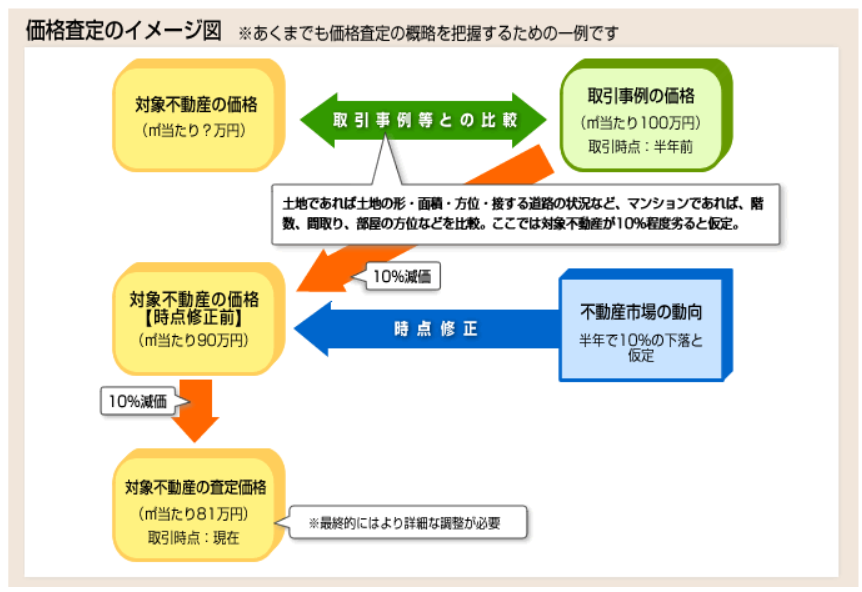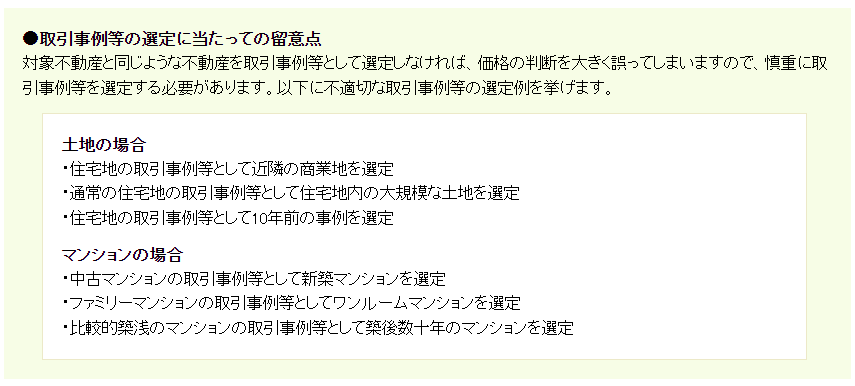Buying a House: Housing PricesWhen buying a house, the price is one of the major determining factors. Since real estate is an asset that is highly individualized, it is extremely difficult to know whether the price being offered for sale is reasonable. In particular, with agency properties, the final sales price is determined through negotiations between the seller and the buyer. It is helpful to understand the following points regarding housing prices and evaluation methods. Point 1: Understanding housing prices
* Since real estate prices are determined for each individual transaction, it is not possible to completely verify such prices with objective data alone. It is important to (1) gather as much information as possible (including advice from experts) and fully examine the price and (2) negotiate in good faith with the other party to the final transaction to ensure that you are satisfied with your own decision. Point 2: Understanding evaluation methods A price assessment of real estate for the purpose of buying and selling is generally called a "price appraisal. There are various methods for price appraisal. The chart below shows the general structure of price appraisal for residential land (land) and condominiums with reference to the "Manual for Price Valuation" issued by the Real Estate Information Center. Please note, however, that a price assessment requires specialized consideration for each individual property. The transaction comparison method (a basic method for assessing land and condominium prices) Land and condominiums are often assessed by the transaction comparison method, which is a method of assessing the price of subject real estate by comparing it with the price of transaction cases of similar real estate. First, the subject property is compared with properties that serve as transaction examples, and the approximate price range of the subject property is assessed based on the prices of transaction examples. Then, certain adjustments are made for differences in transaction timing, taking into account trends in the overall market (this is generally referred to as "point-in-time correction"). Price Assessment Compare the prices The price of the subject property ( ? yen/㎡) ⇔ The price of a transaction example (1,000,000yen/㎡) If the subject property is land, we compare the shape, area, orientation, and condition of the roads it abuts, etc. If it is an apartment, we compare the floor level, layout, and orientation of the rooms. Here, we assume that the subject property is about 10% less in price. ⇩ 10% depreciation Point-in-time correction The price of the subject property (before point-in-time correction) (900,000yen/㎡) ⇐ Trends in the real estate market (assuming a 10% decline in six months) ⇩ 10% depreciation The appraised price of the subject property (810,000yen/㎡) Time of transaction: Current *More detailed final adjustments are needed. (1) Comparison with other transaction cases Compare the individual characteristics of the subject property with those of other transaction cases. (For instance, if it is land, the shape, area, orientation, and condition of the road that it touches, etc. are compared and if it is an apartment building, the number of floors, layout, and orientation of the rooms, etc., are compared.) For each item, the value of the property used as a transaction case for comparison is adjusted based on whether the subject property is better or worse, and the approximate value of the subject property is appraised. (For instance, if the subject property is deemed to be 10% inferior to the transaction example, the value of the transaction example is depreciated by 10%.) Points to keep in mind when selecting transaction examples If real estate similar to the subject property is not selected as a transaction example, the value will be greatly miscalculated, and therefore, transaction examples should be selected carefully. The following are examples of improperly selected transaction examples. In the case of land
In the case of condominiums
(2) Point-in-time correction Compare the market trends at the transaction points of the subject property and the real estate that serves as a transaction example. The price is adjusted according to whether the market price has risen or fallen from the point in time when the property was traded. (For example, if it is determined that the market price has declined by 10% from the point in time when the property was traded, the price calculated based on the comparison with the transaction example is further depreciated by 10%.) (3) Other points to consider The appraisal of the value of the subject property cannot be completed only by comparing it with transaction examples and making a point-in-time correction. It is necessary to take other factors into account make to determine the final assessed value. In assessing a price, it is also important to consult with experts such as a real estate company.
Comments are closed.
|
Details
AuthorArrows International Realty Corp. Archives
June 2023
Categories
All
|




 RSS Feed
RSS Feed